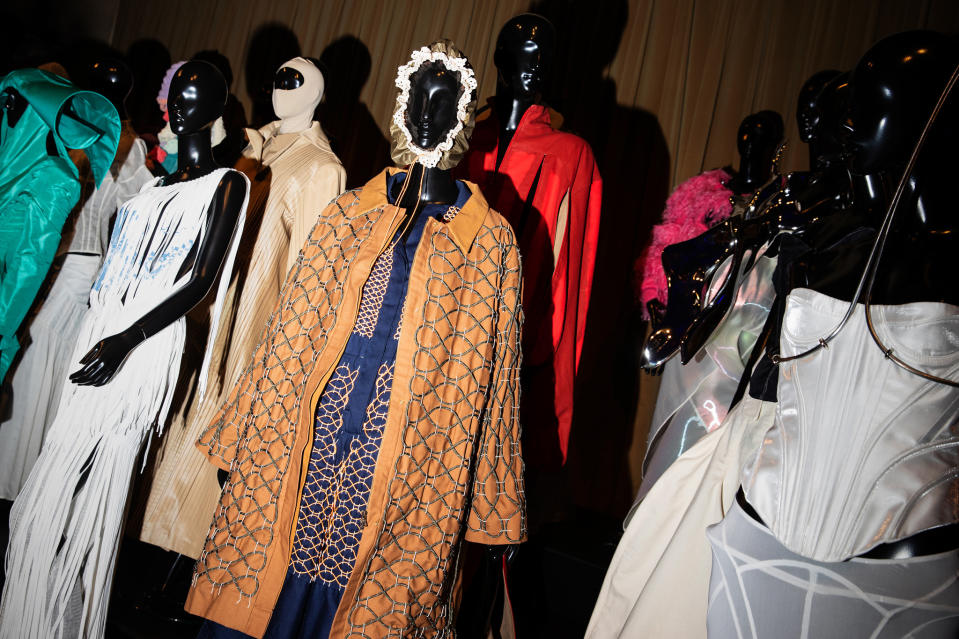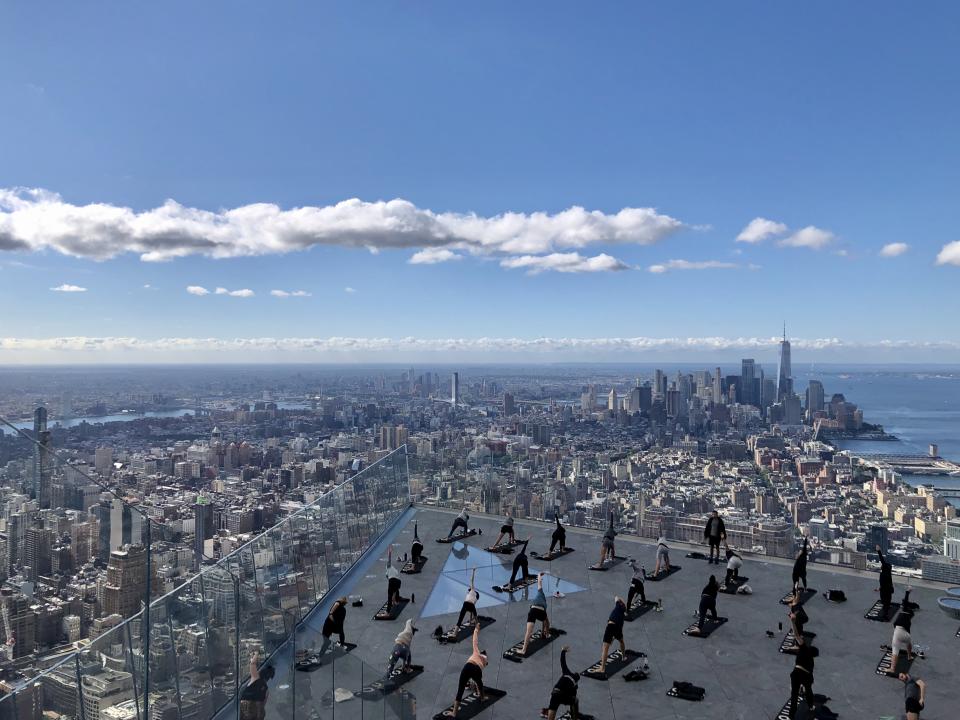Is New York City at Risk of Losing Its Status as a Fashion Capital?

Residents and tourists alike can attest that New York City has lost a bit of its shine post-pandemic, and now a new report indicates that also applies to the fashion industry too.
No longer the country’s hub for garment production, as it once was for nearly a century, the city’s fashion industry is at a crossroads, due to myriad variables. And subsequently that fallout has meant that some of New York’s luster has diminished in comparison to Paris and Milan, according to “At a Crossroads: New York City’s Status as a Global Fashion Capital.” Commissioned by the Partnership for New York City, the analysis was conducted with McKinsey & Co., and input from 40-plus industry executives and insiders. They included representatives from brands, retailers, investors, media, landlords, trade shows and educational institutions.
More from WWD
Social Media Star Morgan Stewart McGraw Brings Her Approachable Renggli Collection to NYFW
EXCLUSIVE: Jason Wu Shares a First Look at His Artist Collaboration for Spring 2025
The In Crowd's Wellness Guide to Tackling New York Fashion Week
There is a lot to consider. The 40-page study suggests that government and industry leaders must decide whether to make a strategic investment in the sector’s future or risk losing fashion’s contributions to the city’s economy, culture and brand. Along with the suggestion that top-notch designers and their companies are less engaged with New York and its institutions, the report said that the biannual New York Fashion Week has become less prominent. Add that with the fact that fewer students are completing programs at the city’s fashion schools and many who do graduate are opting to work in other places. Then there’s the worldwide dispersion of the supply chain, and ongoing issues within it, as well as consumers’ interest in online shopping and how that is impacting commercial real estate and retailers.
In an exclusive interview Friday, Kathryn Wylde, president and chief executive officer of the Partnership for New York City, acknowledged the challenges but expressed optimism for the future. Interviews with employees from such companies as LVMH, Tapestry, Bloomingdale’s, Macy’s and Lafayette 148 indicated that “we’re still the fashion capital, certainly for innovation in ready-to-wear fashion,” she said. “But the question is, ‘Will we be able to maintain that, given the challenges that we face today?’”
The partnership’s members and industry leaders alike understand what is at hand and wanted to take action, Wylde said. “We had been familiar with how important the industry is to our global brand, celebrity status, jobs and the economy,” she said.
Sizing Up the Challenges
Tariffs on China, which were initiated under former president Donald Trump and have continued under President Joe Biden’s administration, is one factor, she said. She also singled out ongoing supply chain issues that started during the pandemic shutdown. The industry’s quandaries include the escalation of e-commerce and fast fashion, and the city’s ever-increasing cost of living and real estate, which is impacting young talent’s means to live and work here. (As of this week, the average monthly rental for a studio apartment in the city was $3,158 for an average of 442 square feet.)
The study highlights how keeping the industry running on all cylinders is key to the city’s economic strength and international image. In 2022, $96 billion in sales of fashion, jewelry, footwear and other goods were sold in the city. That figure includes $51 billion in direct sales and $45 billion in indirect sales. Fashion, of course, is also a source for jobs. Two years ago, the industry employed 130,000-plus residents and accounted for more than $20.4 billion in gross city product. But the industry’s GCP — the market value of all fashion goods and services produced in the city — fell 13.6 percent between 2012 and 2022 and has yet to fully recover, according to the report. There are also almost 50,000 fewer people working in fashion in the five boroughs compared to a decade ago.
In its heyday from 1920 to 1980, the city’s garment district employed about 46 percent of the city’s labor force. However, cheaper offshore apparel production in Hong Kong, Seoul and other locales started chipping away at domestic manufacturing in the ’60s, and that only intensified over time. By 2018 local manufacturing comprised 4 percent of all Garment District jobs, and in turn, city officials agreed to lift the zoning to attract a broader cross-section of businesses. More recently, this year the New York City Economic Development Corp. debuted the M-CORE program to support the renovation of underperforming commercial buildings by providing tax breaks for real estate developers. That initiative includes efforts designed to boost segments of the fashion industry.
Wylde praised one example of a private-public effort that was initiated through M-CORE — a 31-floor tower at 161 Water Street that is owned and operated by WSA Waterfront LLC and Milky 100 LLC, and is being upgraded to attract fashion, arts, creative and technology tenants of all sizes. Retail, offices, production facilities, art galleries, screening rooms, meeting spaces and other spaces will be part of the hybrid layout. The same developer has worked with emerging designers in a Brooklyn space, according to Wylde. “The point is the government is not the first money in and the last money out,” she said.
Fashion’s citywide ecosystem is significantly more dispersed than in decades past. There are currently about 125,000 jobs in the Garment District, which covers approximately 24 blocks from 34th Street to 42nd Street and spans from Fifth Avenue to Ninth Avenue. Those positions aren’t just seamstresses and pattern cutters, though. They include artists, architects, graphic designers, nonprofits, business support services and other commercial tenants. The Midtown neighborhood is not home to the city’s one-stop-shop fashion ecosystem anymore. Starting in the ’90s, numerous big-name designers and major manufacturers, along with smaller ones, moved out of the neighborhood for other Manhattan enclaves and the lure of more space in Brooklyn.
Such hybrid ventures to combine real estate and fashion in a new way are reason for optimism, according to Wylde. For years, subsidizing the Garment District was the focus, but that was when the city was a production center for manufacturing. That model is outdated considering that New York is “an artistic design market center,” Wylde said.
In 2022, more than 2,600 fashion-related degrees and certificates were awarded to students at the Fashion Institute of Technology, The New School’s Parsons School of Design, and Pratt Institute.

If They Can Make It There…
The affordability of living and doing business in the city has “dramatically changed,” Wylde said. “We’re now the third most expensive city in the world after Singapore and Zurich [based on Numbeo’s Cost of Living Index by City.] That’s tough on every industry [in the city.] But our key to success in fashion is that we’ve always attracted young diverse talent. It’s too expensive for them now and they’re able to do things remotely. They don’t have to be here. That combination has created a slowdown in young talent.”
She said that has led to declines in jobs, economic output and student enrollment in design-related schools, which fuels the talent. As far back as former New York City Mayor Michael Bloomberg’s administration, the city has tried different efforts to support incubators, but “those efforts have not been sustainable absent 100 percent government funding,” Wylde said. “Going forward, the key is to engage industry leadership working with the government and the nonprofit sector.”
The recommendations are focused on support from government and other sectors, and leadership from the industry. In the past, government funding for certain initiatives lasted for a few years, before being dropped. “It wasn’t sustainable because there was never a model that industry really embraced. We’re hoping that some of the new models [take hold.]”
Suggestions for Moving Forward
Specific as the study is about the industry’s challenges, it also maps out potential solutions from the start. Recommendations include establishing a designer accelerator with sustained resources; creating a central designer campus for participants to have space to work, pool resources and learn from each other; develop curated storefronts for a rotation of emerging designers; expand industry and school partnerships to groom talent, improve diversity and create more opportunities; reinvigorate New York Fashion Week by supporting up-and-comers, and amping up the industry’s visibility to attract global leaders whether that be by drawing inspiration from non-fashion events like SXSW, introducing AR and VR technologies, or trying other initiatives to interact.
Strengthening New York City’s fashion sector can help the business in other ways too, as noted in the report. Fashion and shopping are attractions for many of the city’s annual visitors, which tallied more than 62 million people last year including 13.5 million international ones. Their $74 billion economic impact included $48 billion in direct spending — a figure that included lodging and is expected to hit $68 million by 2028, according to the report. And in 2017 — the most recent data available, NYFW generated $600 million in income for the city with visitors spending an average of $2,500. That was “far more” than rival fashion weeks in London, Paris and Milan combined, according to the study.
Referring to the city’s pre-COVID-19 older commercial real estate market as “over-mortgaged and overpriced,” Wylde said that about 20 million square footage of “great new office space has been opened in Hudson Yards, [the 73-story One] Vanderbilt [near Grand Central Station,] Penn Plaza and in lower Manhattan.” While the study cites how brands are looking to increase productivity with smaller footprints, it also flagged larger investments like Prada’s purchase of two Fifth Avenue buildings for nearly $850 million, Kering’s $1 billion acquisition nearby, LVMH’s redevelopment of Tiffany & Co.’s flagship, and Hermès’ plans for a permanent location in Williamsburg.

The closure of Barneys New York, Opening Ceremony and Henri Bendel in the past five years, and department stores’ “not having the same amount of resources that they once had, as so much of the business is being generated online” was part of the partnership’s impetus to explore, “What’s the problem? And what can we do about it?” Wylde said.
How Real Estate Factors In
While some developers are making “huge investments” in renovations for commercial real estate, Wylde suggested that owners who choose not to invest in older spaces are seeing their office buildings sit vacant. That could lead to decreased prices and foreclosures, which could then lead to more affordable options and alternative uses for on-the-rise creatives, she said. Recalling how such scenarios in the ’70s and ’80s resulted in an influx of young artists and designers into what became known as SoHo and Tribeca, she hopes a similar outcome to the current commercial real estate problem could be a “silver lining.” Wylde said. “We transformed communities because young artistic people could afford to live and work there.”
To try to put a plan in motion, there will be a meeting on October 24 to bring together representatives from real estate, finance, fashion companies and department stores to discuss the recommendations, get feedback and weigh the likelihood of a public-private partnership. “The industry’s association — the CFDA is national and global. We don’t have a New York association. That’s what we think we need — an industry-focused city one that has all of the dimensions — real estate, marketing, stores, big fashion companies, small designers and universities,” Wylde said.
Best of WWD
What the Highest-paid CEOs at U.S. Fashion and Retail Companies Make
San Francisco Authorities Seize Nearly $2 Million in Suspected Stolen Merchandise
Sign up for WWD's Newsletter. For the latest news, follow us on Facebook, Twitter, and Instagram.
